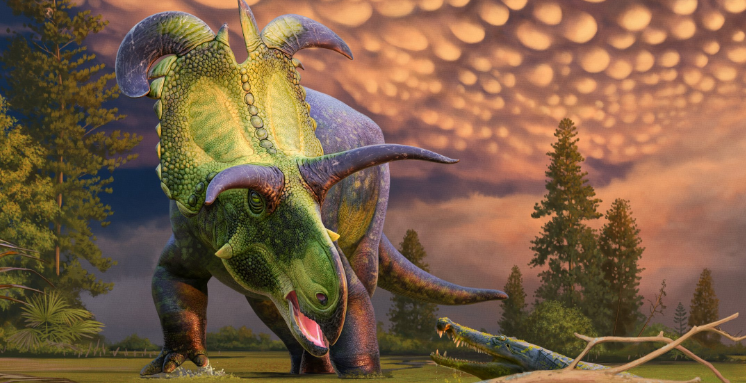This one seems like it is right out of Norse Mythology, thus it’s name…
The Lokiceratops rangiformis, a newly discovered species of horned, plant-eating dinosaur, has been recently unveiled at the Natural History Museum of Utah. Found in the rugged badlands of northern Montana, near the US-Canada border, this dinosaur stands out due to its remarkable skull features, including two massive blade-like horns on its frill and a unique asymmetric spike. The species name, Lokiceratops rangiformis, draws from Norse mythology and the resemblance of its horns to caribou antlers, meaning “Loki’s horned face that looks like a caribou.”
🇺🇸🇨🇦 JUST IN: Unearthing of "Lokiceratops": Largest Frilled Dinosaur Revealed in Montana! Massive blade-like horns adorn its frill, making it a Cretaceous standout from Laramidia's ancient swamps.
[Source: PeerJ] pic.twitter.com/yICkp8eWeY
— RSxAI News (@RSxAI_News) June 20, 2024
Lokiceratops lived approximately 78 million years ago on the island continent of Laramidia, a landmass formed along the eastern shores of what is now the western part of North America. This region was isolated by a vast seaway that split the continent about 100 million years ago, creating unique environmental conditions that fostered the evolution of diverse dinosaur species.
This dinosaur belongs to the ceratopsids, a group that first appeared around 92 million years ago during the Late Cretaceous period. They evolved into various elaborately ornamented species and survived until the end of the dinosaur era. Unique to Lokiceratops are its lack of a nose horn, the extraordinarily large curving horns on its frill—considered the largest among ceratopsians—and an unusual spike in the middle of the frill.
New giant dinosaur with 'bizarre' horns discovered in the wild badlands of Montana – BBC Discover Wildlife https://t.co/eSwLn7t5d2
— adelle (@adellelalane) June 20, 2024
Lokiceratops predates the famous Triceratops by at least 12 million years and was the largest horned dinosaur of its era. The findings, published in the scientific journal PeerJ, emphasize the dinosaur’s extravagant headgear, underscoring evolutionary adaptations possibly driven by sexual selection aimed at producing visually striking features to attract mates or deter rivals.
The discovery also highlights a surprising level of diversity within the horned dinosaurs in a relatively confined area of Laramidia, challenging previous assumptions about dinosaur cohabitation. The area’s fossils suggest a high degree of endemism, indicating that many distinct species may have evolved in close proximity.
Dinosaur from Montana had horns like Norse god Loki's blades https://t.co/4NeW7R3HL1 pic.twitter.com/u5AhbzivDp
— CNA (@ChannelNewsAsia) June 20, 2024
The study indicates that rapid evolutionary changes, potentially driven by sexual selection, could explain the swift turnover of these species, which lasted only about 100,000 to 200,000 years each. This rapid evolution reflects changes in genes responsible for horn and frill development, leading to significant variations in their shapes and sizes.
Major Points
- New Dinosaur Species Identified: Lokiceratops rangiformis, a horned, plant-eating dinosaur, was recently unveiled at the Natural History Museum of Utah, featuring unique large blade-like horns and a distinctive asymmetric spike.
- Ancient Habitat: This dinosaur lived approximately 78 million years ago on the island continent of Laramidia, now known as the western part of North America, which was isolated by a vast seaway.
- Unique Features: Lokiceratops is notable for lacking a nose horn but having the largest frill horns ever seen among ceratopsians, along with a peculiar spike in the middle of its frill.
- Evidence of Rapid Evolution: The study suggests rapid evolutionary changes possibly driven by sexual selection, affecting horn and frill shapes and sizes, leading to significant species diversity within a short geological span.
- High Diversity in a Confined Area: The discovery of Lokiceratops and other ceratopsians in northern Montana indicates a high level of endemism and suggests that dinosaur diversity in this region is likely underestimated.
Charles William III – Reprinted with permission of Whatfinger News



